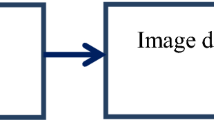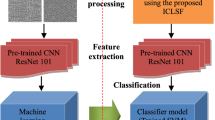Abstract
Despite tighter conservation regulations, demand for timber products has continued to increase due to growing population. Normally, experts identify the wood species based on the pattern of the wood surface texture. However, manual inspection on wood texture is tedious, time-consuming, impractical and cost-ineffective for a human to analyze a large number of timber species. Therefore, a reliable automatic wood recognition system is needed in order to classify the wood species efficiently. The proposed system includes image acquisition, image quality assessment module (IQA), image deblurring, feature extraction and classification. In this research, the wood images are motion-blurred due to imperfections in the imaging and capturing process. Hence, an IQA module is proposed to monitor the quality of images before proceeding to the next stage which is the feature extraction process. The IQA module will determine whether the image has to undergo the image deblurring process based on the image quality value. If the image is of low quality based on the image quality value obtained, then the image will be deblurred before the feature extraction procedure. A reliable motion deblurring technique, which is based on Lucy–Richardson algorithm, is employed to enhance the motion-blurred images before proceeding to the next stage, which is the feature extraction process. Then, a statistical feature extraction technique is proposed to extract 24 features from each wood image. Finally, a support vector machine is used to classify the 20 tropical wood species.







Similar content being viewed by others
References
Abang MZ, Ramli MS, Halim SA (2017) Application of blind deconvolution and Lucy–Richardson deconvolution for image debluring. J Fundam Appl Sci 9(5S):232–244
Angelis GI, Gillam JE, Kyme AZ (2018) Image-based modelling of residual blurring in motion corrected small animal PET imagig using motion dependent point spread functions. Biomed Phys Eng Express 4(3):035032
Aziz F, Arof H, Mokhtar N, Shah NM, Khairuddin ASM, Hanafi E et al (2018) Waste level detection and HMM based collection scheduling of multiple bins. PLoS ONE 13(8):e0202092. https://doi.org/10.1371/journal.pone.0202092
Barrack F, Scuffham J, McQuaid S (2018) Septal penetration correction in I-131 imaging following thyroid cancer treatment. Phys Med Biol 63(7):075012
Bremanath R, Nithiya B, Saipriya R (2009) Wood species recognition using GLCM and correlation. In: International conference on advances in recent technology in communication and computing, Kerala, India, 27–28 Oct 2009, pp 615–619. https://ieeexplore.ieee.org/document/5329080. Accessed Nov 2009
Buccini A, Donatelli M, Ferri F (2018) Weakly constrained Lucy–Richardson with applications to inversion of light scattering data. J Sci Comput 74(2):786–804
Chang CC, Lin CJ (2011) LIBSVM: a library for support vector machines. ACM Trans Intell Syst Technol 2:27
Chow LS, Rajagopal H, Paramesran R (2016) Correlation between subjective and objective assessment of magnetic resonance (MR) images. Magn Reson Imaging 34:820–831
Daassi-Gnaba H, Oussar Y, Merlan M, Ditchi T, Geron E, Hole S (2018) Moisture content recognition for wood chips in pile using supervised classification. Wood Sci Technol 52(5):1195–1211
Dahle GA (2017) Influence of bark on the mapping of mechanical strain using digital image correlation. Wood Sci Technol 51(6):1469–1477
Dawson-Andoh B, Adedipe OE (2012) Rapid spectroscopic separation of three Canadian softwoods. Wood Sci Technol 46:1193–1202
Defoirdt N, Sen A, Dhaene J, De Mil T, Pereira H, Van Acker J, Van den Bulcke J (2017) A generic platform for hyperspectral mapping of wood. Wood Sci Technol 51(4):887–907
Denzler JK, Weidenhiller A, Golser M (2013) Comparison of different approaches for automatic bark detection on log images. Wood Sci Technol 47:749–761
Esteban LG, Palacios P, Conde M, Fernandez FG, Garcia-Iruela A, Gonzalez-Alonso M (2017) Application of artificial neural networks as a predictive method to differentiate the wood of Pinus sylvestris L. and Pinus nigra Arn subsp. salzmannii Dunal Franco. Wood Sci Technol 51(5):1249–1258
Fouad A, Mbarek N, Mimoun M (2018) An improved Richardson–Lucy algorithm based on genetic approach for satellite image restoration. Int Arab J Inf Technol 15(4):715–720
Gu YH, Vicen R, Andersson H (2009) Wood defect classification based on image analysis and support vector machines. Wood Sci Technol 44(4):693–704
Hsu C-W, Chang C-C, Lin C-J (2003) A practical guide to support vector classification. Technical report, Department of Computer Science, National Taiwan University
Ibrahim I, Khairuddin ASM, Arof H, Abu Talip MS, Yusof R (2017) Tree species recognition system based on macroscopic image analysis. Wood Sci Technol 51:431–444
Ibrahim I, Khairuddin ASM, Arof H, Hanafi E, Yusof R (2018) Statistical feature extraction method for wood species recognition system. Eur J Wood Prod 76(1):345–356
Iglesias C, Anjos O, Martinez J, Pereira H, Taboada J (2015) Prediction of tension properties of cork from its physical properties using neural networks. Eur J Wood Prod 73:347–356
Khalid M, Lee ELY, Yusof R, Nadaraj M (2008) Design of an intelligent wood species recognition system. Int J Simul Syst Sci Technol 9(3):9–19
Naganathan GK, Cluff K, Samal A, Calkins CR, Jones DD, Meyer GE, Subbiah J (2016) Three dimensional chemometric analyses of hyperspectral images for beef tenderness forecasting. J Food Eng 169:309–320
Pahlberg T, Johansson E, Hagman O, Thurley M (2015) Wood fingerprint recognition using knot n eighbourhood K-plet descriptors. Wood Sci Technol 49(1):7–20
Qin R, Qiu Q, Lam JHM, Tang AMC, Leung MWK, Lau D (2018) Health assessment of tree trunk by using acoustic-laser technique and sonic tomography. Wood Sci Technol 52(4):1113–1132
Sebera V, Praus L, Tippner J, Kunecky J, Čepela J, Wimmer R (2014) Using optical full-field measurement based on digital image correlation to measure strain on a tree subjected to mechanical load. Trees 28(4):1173–1184
Wang Z, Li Q (2011) Information content weighting for perceptual image quality assessment. IEEE Trans Image Process 20:1185–1198
Wang Z, Simoncelli EP, Bovik AC (2003) Multi-scale structural similarity for image quality assessment. In: Asilomar conference on signals, systems and computers. IEEE, pp 1398–1402
Wang HJ, Zhang GQ, Qi HN (2013) Wood Recognition using image texture features. PLoS ONE 8(10):e76101
Woods RE, Gonzalez RC (2008) Digital Image Processing, 3rd edn. Pearson Education Inc, New Jersey
Xue W, Zhang L, Mou X, Bovik AC (2014) Gradient magnitude similarity deviation: a highly efficient perceptual image quality index. IEEE Trans Image Process 23:684–695
Yusof R, Khalid M, Khairuddin ASM (2013a) Application of kernel-genetic algorithm as nonlinear feature selection in tropical wood species recognition system. Comput Electron Agric 93:68–77
Yusof R, Khalid M, Khairuddin ASM (2013b) Fuzzy logic-based pre-classifier for tropical wood species recognition system. Mach Vis Appl 9:9–19
Zamri IP, Cordova F, Mohd Khairuddin AS, Mokhtar N, Rubiyah Y (2016) Tree species classification based on image analysis using Improved-Basic Gray Level Aura Matrix. Comput Electron Agric 124:227–233
Zhang L, Zhang D, Mou X (2011) FSIM: a feature similarity index for image quality assessment. IEEE Trans Image Process 20:2378–2386
Acknowledgements
Research funding was provided by RU Grant—Faculty Programme by Faculty of Engineering, University of Malaya with Project Number RF001A-2018.
Author information
Authors and Affiliations
Corresponding author
Ethics declarations
Conflict of interest
On behalf of all authors, the corresponding author states that there is no conflict of interest.
Additional information
Publisher's Note
Springer Nature remains neutral with regard to jurisdictional claims in published maps and institutional affiliations.
Rights and permissions
About this article
Cite this article
Rajagopal, H., Khairuddin, A.S.M., Mokhtar, N. et al. Application of image quality assessment module to motion-blurred wood images for wood species identification system. Wood Sci Technol 53, 967–981 (2019). https://doi.org/10.1007/s00226-019-01110-2
Received:
Published:
Issue Date:
DOI: https://doi.org/10.1007/s00226-019-01110-2




